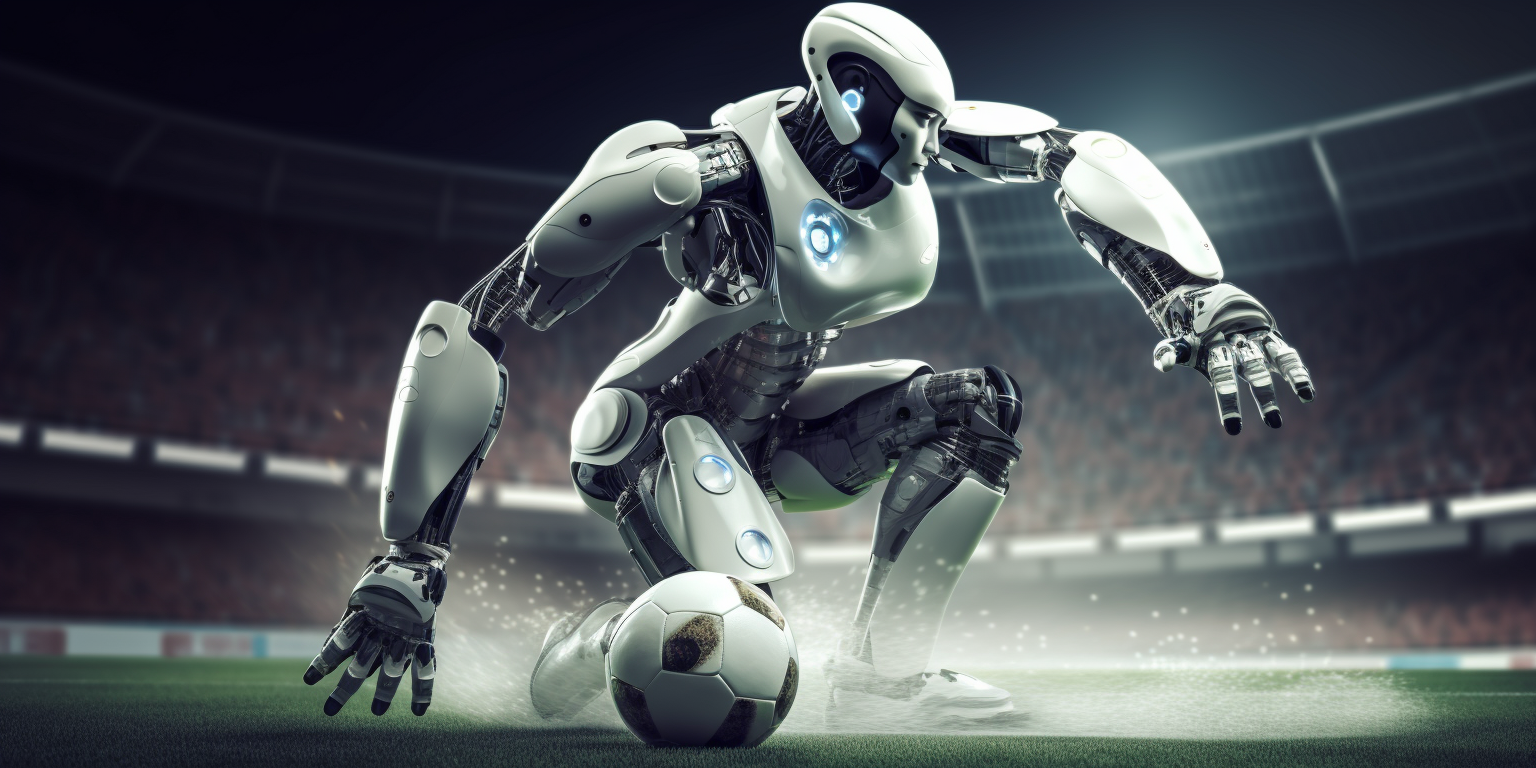Robotics has been making significant strides in various industries, and sports training and performance enhancement are no exception. With the help of robotics, athletes can improve their skills, prevent injuries, and achieve better results.
One of the main advantages of robotics in sports training is the ability to analyze and improve biomechanics. By using sensors and cameras, robots can capture and analyze an athlete’s movements, providing valuable insights into their technique and form. This information can then be used to make adjustments and improvements, leading to better performance.
In addition to performance enhancement, robotics can also play a crucial role in injury prevention. By analyzing an athlete’s movements, robots can identify potential areas of weakness or strain and provide targeted exercises to strengthen those areas. This can help reduce the risk of injury and keep athletes in top condition.
Another area where robotics can be beneficial is in the development of specialized training equipment. For example, robots can be used to create custom training machines that mimic specific sports movements, allowing athletes to train in a more targeted and effective way.
Overall, the role of robotics in sports training and performance enhancement is becoming increasingly important. By providing valuable insights into biomechanics, preventing injuries, and developing specialized training equipment, robots are helping athletes achieve their full potential.
Benefits of Robotics in Sports
Robotics has become an increasingly popular tool in sports training and performance enhancement. With the help of advanced technology, athletes can now use robotics to improve their biomechanics, prevent injuries, and enhance their overall performance.
One of the main benefits of robotics in sports training is the ability to analyze an athlete’s movements in real-time. This allows coaches and trainers to identify areas where an athlete may be struggling and make adjustments to their training regimen accordingly. By using robotics to analyze an athlete’s movements, coaches can help them improve their technique and reduce the risk of injury.
Another benefit of robotics in sports training is the ability to simulate game-like situations. This allows athletes to practice their skills in a controlled environment, which can help them prepare for real-world scenarios. For example, a basketball player can use a robotic arm to simulate a defender and practice their shooting technique under pressure.
Robotics can also be used to enhance an athlete’s physical abilities. For example, exoskeletons can be used to help athletes lift heavier weights or run faster. These devices can help athletes push their bodies to the limit and achieve new levels of performance.
Finally, robotics can be used to prevent injuries. By analyzing an athlete’s movements, coaches can identify areas where they may be at risk for injury and make adjustments to their training regimen. Additionally, robotics can be used to help athletes recover from injuries more quickly by providing targeted rehabilitation exercises.
In conclusion, robotics has become an essential tool in sports training and performance enhancement. By using robotics to analyze an athlete’s movements, simulate game-like situations, enhance physical abilities, and prevent injuries, athletes can achieve new levels of performance and reach their full potential.
Types of Robotic Devices
Robotics has revolutionized the way we approach sports training and performance enhancement. With the help of biomechanics and injury prevention, robotic devices have become an integral part of sports training. Here are some of the most common types of robotic devices used in sports training:
1. Exoskeletons: These are wearable robotic devices that help athletes improve their strength and endurance. They are particularly useful for athletes who have suffered injuries and need to rebuild their strength.
2. Motion capture systems: These systems use cameras and sensors to track an athlete’s movements. They are used to analyze an athlete’s technique and identify areas for improvement.
3. Virtual reality systems: These systems create a simulated environment that allows athletes to practice their skills in a safe and controlled environment. They are particularly useful for sports that require a high degree of precision, such as golf or archery.
4. Robotic trainers: These are robotic devices that mimic the movements of a coach or trainer. They are used to help athletes improve their technique and develop muscle memory.
5. Rehabilitation robots: These are robotic devices that are used to help athletes recover from injuries. They are particularly useful for athletes who have suffered injuries to their arms or legs.
Overall, robotics has had a significant impact on sports training and performance enhancement. By using biomechanics and injury prevention, robotic devices have helped athletes improve their technique, strength, and endurance. As technology continues to advance, we can expect to see even more innovative uses of robotics in sports training.
Biomechanics and Performance Enhancement
Robotics has become an increasingly popular tool in sports training and performance enhancement. With the ability to analyze and improve biomechanics, prevent injuries, and enhance overall performance, robotics is revolutionizing the way athletes train and compete.
One of the key benefits of robotics in sports training is its ability to analyze and improve biomechanics. By using sensors and cameras, robotics can capture and analyze an athlete’s movements, providing valuable data on their technique and form. This data can then be used to identify areas for improvement and develop targeted training programs to enhance performance.
In addition to improving technique, robotics can also help prevent injuries. By analyzing an athlete’s movements, robotics can identify potential areas of weakness or strain, allowing coaches and trainers to develop injury prevention strategies. This can include targeted exercises and stretches, as well as modifications to training programs to reduce the risk of injury.
Finally, robotics can also enhance overall performance by providing real-time feedback and analysis. By using sensors and cameras, robotics can provide instant feedback on an athlete’s performance, allowing them to make adjustments and improvements on the fly. This can be particularly useful in high-pressure situations, such as competitions, where athletes need to make split-second decisions and adjustments.
Overall, robotics is playing an increasingly important role in sports training and performance enhancement. By analyzing biomechanics, preventing injuries, and enhancing overall performance, robotics is helping athletes reach new heights and achieve their full potential.
Injury Prevention and Rehabilitation
Robotics has become an increasingly popular tool in sports training and performance enhancement. With the help of advanced technology, athletes can now improve their skills and prevent injuries through the use of biomechanics and robotics.
One of the main benefits of robotics in sports training is injury prevention. By analyzing an athlete’s movements and identifying potential areas of weakness, coaches and trainers can use robotics to create personalized training programs that target those specific areas. This can help reduce the risk of injury and keep athletes performing at their best.
In addition to injury prevention, robotics can also be used for rehabilitation. After an injury, athletes often need to rebuild strength and flexibility in the affected area. Robotics can provide a controlled environment for rehabilitation exercises, allowing athletes to safely and effectively regain their strength and mobility.
Another way that robotics can enhance sports performance is through the analysis of biomechanics. By using sensors and cameras, coaches and trainers can gather data on an athlete’s movements and identify areas where they can improve. This information can then be used to create personalized training programs that target those specific areas, helping athletes to perform at their best.
Overall, the role of robotics in sports training and performance is becoming increasingly important. By using advanced technology to analyze biomechanics and prevent injuries, athletes can improve their skills and stay at the top of their game. Whether it’s through injury prevention, rehabilitation, or performance enhancement, robotics is changing the way we approach sports training and performance.
Limitations
Robotics has become an increasingly popular tool in sports training and performance enhancement. With the ability to analyze biomechanics and prevent injuries, robotics has revolutionized the way athletes train and perform.
One of the main advantages of robotics in sports training is the ability to analyze an athlete’s biomechanics. By using sensors and cameras, robotics can track an athlete’s movements and provide feedback on their technique. This feedback can help athletes make adjustments to their form and improve their performance.
Another benefit of robotics in sports training is injury prevention. By analyzing an athlete’s movements, robotics can identify potential areas of weakness or strain and provide recommendations for injury prevention. This can help athletes avoid injuries and stay healthy throughout their training and competition.
Despite these advantages, there are limitations to the use of robotics in sports training. One limitation is the cost. Robotics technology can be expensive, making it difficult for smaller teams or individual athletes to access. Additionally, robotics technology is not always readily available, which can limit its use in certain sports or training environments.
Another limitation is the lack of personalization. While robotics can provide valuable feedback on an athlete’s technique, it cannot replace the personalized coaching and guidance that a human coach can provide. Additionally, robotics technology may not be able to account for individual differences in athletes, such as body type or injury history.
In conclusion, robotics has become an important tool in sports training and performance enhancement. While there are limitations to its use, the benefits of robotics in analyzing biomechanics and preventing injuries make it a valuable asset for athletes and coaches alike.
Robotics has become an increasingly popular tool in sports training and performance enhancement. With the ability to analyze biomechanics and prevent injuries, robotics is revolutionizing the way athletes train and perform.
One of the main benefits of robotics in sports training is the ability to analyze biomechanics. By using sensors and cameras, robotics can track an athlete’s movements and provide detailed feedback on their technique. This allows coaches and trainers to identify areas for improvement and develop personalized training programs to enhance performance.
In addition to performance enhancement, robotics can also play a crucial role in injury prevention. By analyzing an athlete’s movements, robotics can identify potential areas of weakness or strain and provide recommendations for corrective exercises or modifications to their training regimen. This can help prevent injuries before they occur, allowing athletes to stay healthy and perform at their best.
Another benefit of robotics in sports training is the ability to simulate game-like situations. By using virtual reality technology, athletes can practice in a safe and controlled environment, allowing them to develop their skills and improve their performance without the risk of injury.
Overall, robotics is a valuable tool in sports training and performance enhancement. By analyzing biomechanics, preventing injuries, and simulating game-like situations, robotics is helping athletes reach their full potential and achieve their goals.






